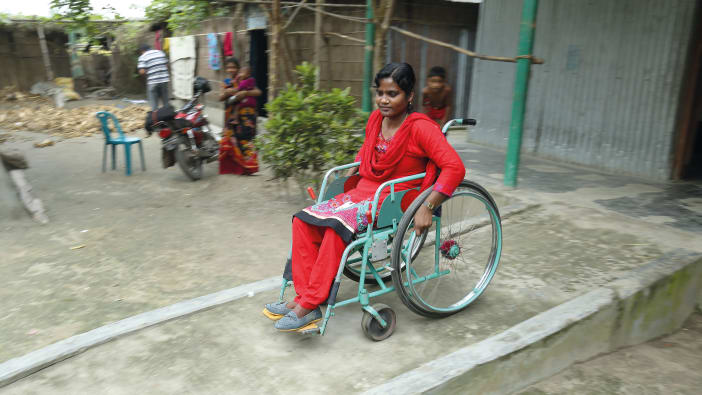This article is adapted with permission from an article by Alexandra Frean, © The Times, London, 26th July 2005. No copying, photocopying, reproduction or electronic rights are available in this article without the prior permission of the copyright holder. www.timesonline.co.uk
There are around 20 million people with disabilities in low-income countries who need wheelchairs. Most of those available locally are gifts from charities in the West and may not be suitable for rough paths and tracks. They are usually old models and are passed from user to user. Because these chairs were made to fit well-fed Westerners, they are often the wrong size and shape, which can lead to serious accidents.
In the UK, life expectancy for someone confined to a wheelchair is the same as for an able-bodied person, but the World Health Organisation estimates that the average life expectancy of someone in a low-income country who loses the use of their legs is just two to three years. Badly fitted wheelchairs and lack of mobility may cause pressure sores which can become infected. If people have no access to antibiotics they may die as a result of these infections.
Each year many thousands of people injure their backs, are injured in conflicts or by land mines. One in 400 people worldwide has cerebral palsy. Many of these people will require a wheelchair.
Appropriate design
Motivation is a UK-based organisation that helps provide suitable and affordable wheelchairs for disabled people across the world. At first it worked with local disabled people’s organisations, setting up workshops where local people could build and repair equipment. However, their new design is mass-produced in China for local assembly world wide. This makes the chairs cheaper to produce. They can then be adjusted locally to fit the size and needs of each user. The chair has a simple design and uses common materials and parts so it is low-cost, and easy to maintain and repair locally. Its design allows it to cross most potholed tracks and fields. Motivation has designed a short training course for assembling the chairs to fit local users – each chair usually takes four hours to assemble and adjust.
Regaining independence
Motivation has helped to distribute 22,000 wheel chairs so far. David Constantine, co-founder of Motivation explains, ‘ We are handing people independence and control over their own lives’.
Motivation, Brockley Academy, Brockley Lane, Backwell, Bristol, BS48 4AQ, UK
Email: [email protected]
Website: www.motivation.org.uk
Case study: A better life
Kithsiri Perera is 37 and lives in Pokunuwita, Sri Lanka, with his mother and two sisters. He used to run a successful fish stall until an accident three years ago left him unable to walk. After 18 months in hospital he returned home, but because he didn’t have a wheelchair he was unable to leave his home.
Some of Kithsiri’s fellow market traders shared their savings to buy a chair for him, but it was an old one and had no seat, just rope strung across the frame. Although it helped him to move from room to room, it couldn’t carry him over muddy paths.
‘Most days, I did nothing at all,’ he says. ‘I’d just sit or lie down. I had not been out of the house for 18 months. There were times when I thought my life was pointless. But I wanted to find a way to work again. Before the accident I ran a fish stall that had belonged to my father and my grandfather. It was very successful. I had a good life. I had everything I wanted. And now I want my life back.’
Kithsiri Perera’s dream of a better life now looks within reach. Motivation has supplied him with a new wheelchair, a three-wheeler designed for use on the rough terrain of rural areas. He is making great progress, rebuilding his self-confidence and regaining mobility. He says, ‘I see active people and it makes me think that I would like to be like them and have my business again. That is my plan.’








